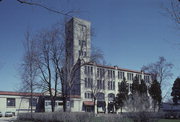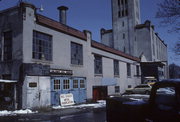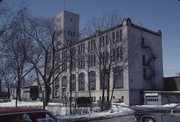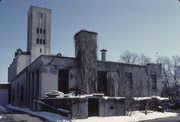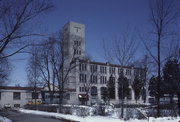Property Record
550 ELIZABETH ST
Architecture and History Inventory
| Historic Name: | Waukesha Pure Food Company |
|---|---|
| Other Name: | WAUKESHA PURE FOOD COMPANY |
| Contributing: | |
| Reference Number: | 16813 |
| Location (Address): | 550 ELIZABETH ST |
|---|---|
| County: | Waukesha |
| City: | Waukesha |
| Township/Village: | |
| Unincorporated Community: | |
| Town: | |
| Range: | |
| Direction: | |
| Section: | |
| Quarter Section: | |
| Quarter/Quarter Section: |
| Year Built: | 1916 |
|---|---|
| Additions: | 1921 |
| Survey Date: | 1980 |
| Historic Use: | industrial bldg/manufacturing facility |
| Architectural Style: | Spanish/Mediterranean Styles |
| Structural System: | |
| Wall Material: | Concrete |
| Architect: | |
| Other Buildings On Site: | |
| Demolished?: | No |
| Demolished Date: |
| National/State Register Listing Name: | Waukesha Pure Food Company |
|---|---|
| National Register Listing Date: | 10/28/1983 |
| State Register Listing Date: | 1/1/1989 |
| National Register Multiple Property Name: | Multiple Resources of Waukesha |
| Additional Information: | A 'site file' exists for this property. It contains additional information such as correspondence, newspaper clippings, or historical information. It is a public record and may be viewed in person at the Wisconsin Historical Society, State Historic Preservation Office. Architectural Description: The Waukesha Pure Food Company building was constructed in two phases. The main portion of the building, dominated by a seven story tower, was built from c. 1913 to 1916; a one story warehouse wing was added to the west between 1922 and 1929. [A, C]. Structural tile and poured concrete comprise the exterior walls, and red clay tile roofs cap the structure. Streamlined piers delineate the exterior, creating eight vertical divisions which contain three tiers of windows. Widows on the first story are segmentally arched; second and third story windows, as well as those on the tower, are rectangular units occurring in groups of threes. Windows mullions unite the second and third story units and echo the verticality of the piers. Similar detailing appears on the rectangular tower, which contains a water tower on the upper level. While the exterior has not been greatly altered, the interior has been altered for office and light industrial uses and none of the original industrial equipment remains. The structure is in good condition. There are six other buildings on the Fred Portz Jr. property which do not contribute to the significance of the property. A single-story steel-sided building is attached to the north side of the original structure, and a truck well is attached to the east side of the original building. A one-story building with a wood front is located on the east side of the property, and three other one-story metal buildings adjoin the railroad tracks on the north lot line of the property. Architectural Significance: The Waukesha Pure Food Company building, one of Waukesha's finest industrial structures, is architecturally significant as a representative example of a type and period of construction. The simple, strong lines and detailing of the building combine to create a fine example of industrial Gothic design, unparalelled in the city. In addition, the large scale and dominant tower result in a highly visible building, an important local landmark. Historical Statement: "Associated with Industry" This industrial building was originally constructed in 1916 for the Waukesha Pure Food Company, makers of Jiffy-Jell, the first fruit flavored gelatin dessert to be marketed nationally. The company was founded by Otis E. and Fred S. Glidden of New York State who were joined locally by Mayor C. A. Estberg and Charles E. Nelson. [B]. Jiffy-Jell was successfully marketed and quickly became a national success. Unfortunately, its decline was almost as fast. Alcohol was used to preserve the fruit "essence" used in the mix and first World War I, then Prohibition made that commodity scarce. After attempts to replace the alcohol failed, the company closed in 1921. [E]. The building has had several industrial uses since, chief among those was as the base of operations for the Waukesha Mineral Water Company. [D]. |
|---|---|
| Bibliographic References: | A. Sanborn Perris Map of Waukesha 1922. B. Waukesha Freeman, March 1, 1917, p. 1. C. Sanbor Perris Map of Waukesha 1929. D. Waukesha City Directories 1916, 1919, 1923, 1929. E. "Lack of Alcohol Caused Downfall," Freeman Centennial Edition, Sec. H-II, p. 23 1959. |
| Wisconsin Architecture and History Inventory, State Historic Preservation Office, Wisconsin Historical Society, Madison, Wisconsin |

